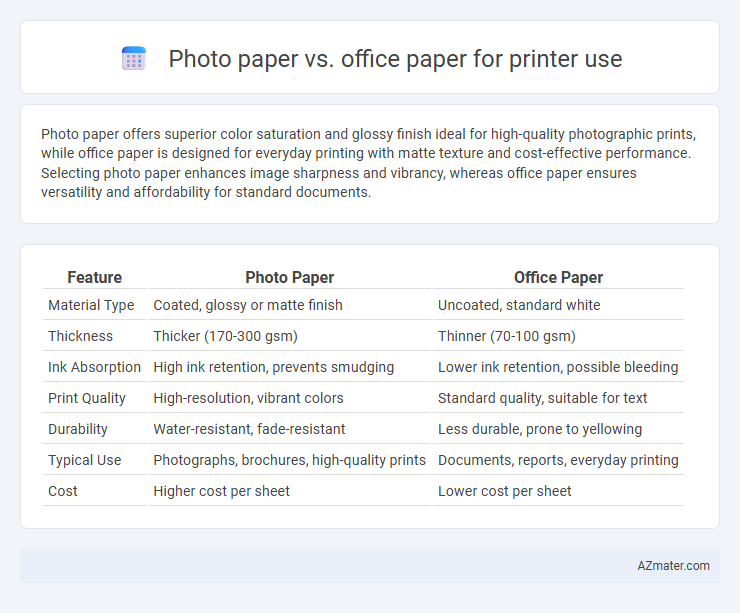Photo paper offers superior color saturation and glossy finish ideal for high-quality photographic prints, while office paper is designed for everyday printing with matte texture and cost-effective performance. Selecting photo paper enhances image sharpness and vibrancy, whereas office paper ensures versatility and affordability for standard documents.
Table of Comparison
| Feature | Photo Paper | Office Paper |
|---|---|---|
| Material Type | Coated, glossy or matte finish | Uncoated, standard white |
| Thickness | Thicker (170-300 gsm) | Thinner (70-100 gsm) |
| Ink Absorption | High ink retention, prevents smudging | Lower ink retention, possible bleeding |
| Print Quality | High-resolution, vibrant colors | Standard quality, suitable for text |
| Durability | Water-resistant, fade-resistant | Less durable, prone to yellowing |
| Typical Use | Photographs, brochures, high-quality prints | Documents, reports, everyday printing |
| Cost | Higher cost per sheet | Lower cost per sheet |
Understanding Photo Paper vs Office Paper
Photo paper features a glossy or matte finish designed to enhance color vibrancy and detail, making it ideal for high-quality photo printing with inkjet printers. Office paper, typically made from wood pulp with a smooth, uncoated surface, is optimized for everyday document printing, ensuring quick ink absorption and minimal smudging. Selecting the appropriate paper type impacts print quality, durability, and ink usage, with photo paper offering superior image reproduction and office paper providing cost-effective practicality.
Key Differences in Composition
Photo paper contains a high-gloss or matte coating made from resin or polymer layers designed to absorb printer ink quickly and produce vibrant, sharp images with excellent color accuracy. Office paper is generally uncoated or lightly coated, made from wood pulp with a porous surface that absorbs ink more slowly, resulting in less saturated colors and lower image resolution. The thickness and weight of photo paper are typically higher, improving durability and preventing ink bleed-through, unlike standard office paper that prioritizes economical printing and versatility for text documents.
Print Quality Comparison
Photo paper delivers superior print quality with higher color accuracy, richer saturation, and sharper image details due to its coated surface designed for ink absorption and vibrant output. Office paper, typically uncoated or lightly coated, results in less vivid prints with lower resolution, suitable mainly for text documents and basic graphics. Choosing photo paper enhances the visual impact of photographs and high-quality images, while office paper prioritizes cost-effectiveness over print fidelity.
Ideal Uses for Photo Paper
Photo paper is specifically designed for high-quality photo printing, offering vibrant colors, sharp details, and a glossy or matte finish that enhances image clarity. It is ideal for printing photographs, art reproductions, and marketing materials where visual impact is crucial. Unlike standard office paper, photo paper handles ink absorption better, preventing smudging and ensuring longer-lasting prints with enhanced durability.
Best Applications for Office Paper
Office paper is ideal for everyday printing tasks such as documents, reports, and memos due to its standard weight and smooth texture that supports clear text reproduction. It performs well in inkjet and laser printers by absorbing toner and ink efficiently, reducing smudging and bleed-through compared to photo paper. Designed for cost-effectiveness and versatility, office paper is best suited for high-volume printing and professional presentations where clarity and readability are essential.
Cost Considerations
Photo paper typically costs significantly more per sheet compared to standard office paper, often priced at several times the cost due to its specialized coatings designed for high-quality image reproduction. Office paper is more economical for everyday printing tasks, offering a balance of affordability and adequate quality for text documents and general use. Choosing photo paper primarily impacts budget when printing large volumes or high-resolution images, making it essential to match paper type with specific printing needs to manage overall costs effectively.
Impact on Printer Longevity
Photo paper, designed with a glossy or matte coating, requires more precise ink application, which may increase wear on printer nozzles and rollers over time. Office paper, typically thinner and uncoated, allows smoother paper feed and reduces the risk of jams, supporting longer printer lifespan. Frequent use of photo paper can accelerate maintenance needs and potential printhead clogging compared to consistent use of standard office paper.
Ink Absorption and Color Reproduction
Photo paper features a specialized coating that enhances ink absorption, preventing smudging and allowing for sharp, vibrant color reproduction ideal for high-quality photo prints. Office paper lacks this coating, resulting in more ink spreading and duller colors, which suits general document printing but is less effective for images. High ink absorption on photo paper ensures detailed gradients and rich tones that office paper cannot achieve.
Environmental and Recycling Factors
Photo paper often contains a plastic coating that hinders biodegradability and complicates recycling processes, making it less eco-friendly compared to office paper. Office paper, typically uncoated and composed of recycled fibers, offers higher recyclability and a smaller environmental footprint. Choosing office paper reduces landfill waste and energy consumption during recycling, supporting sustainable printing practices.
Choosing the Right Paper for Your Printing Needs
Photo paper delivers high-quality, vibrant prints ideal for images and professional photography due to its glossy or matte coating that enhances color saturation and sharpness. Office paper, typically lightweight with a matte finish, is best suited for everyday document printing, offering cost-effective performance and reliable ink absorption for text clarity. Selecting the right paper depends on the print purpose: use photo paper for detailed image reproduction and office paper for routine printing tasks to balance quality and cost.

Infographic: Photo paper vs Office paper for Printer use
 azmater.com
azmater.com